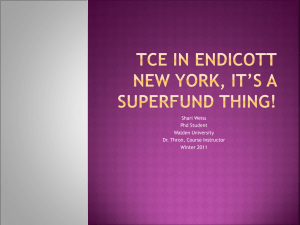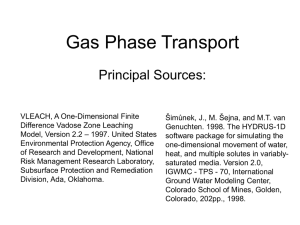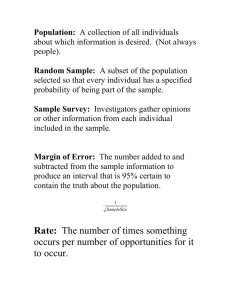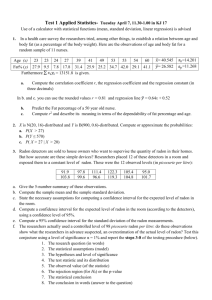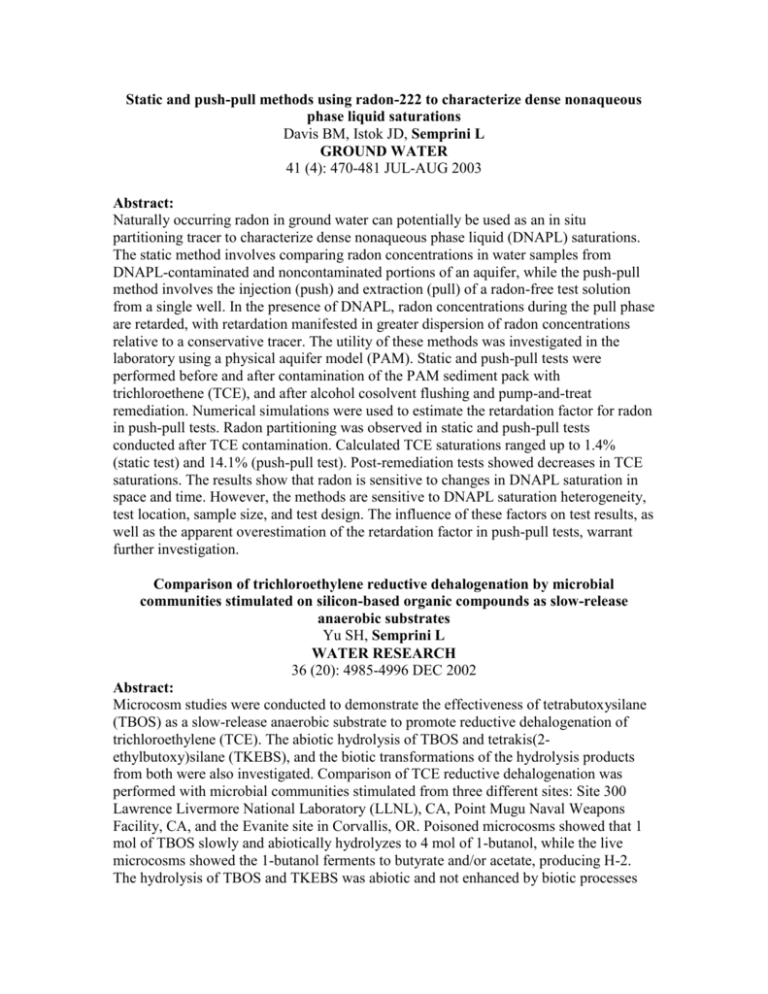
Static and push-pull methods using radon-222 to characterize dense nonaqueous
phase liquid saturations
Davis BM, Istok JD, Semprini L
GROUND WATER
41 (4): 470-481 JUL-AUG 2003
Abstract:
Naturally occurring radon in ground water can potentially be used as an in situ
partitioning tracer to characterize dense nonaqueous phase liquid (DNAPL) saturations.
The static method involves comparing radon concentrations in water samples from
DNAPL-contaminated and noncontaminated portions of an aquifer, while the push-pull
method involves the injection (push) and extraction (pull) of a radon-free test solution
from a single well. In the presence of DNAPL, radon concentrations during the pull phase
are retarded, with retardation manifested in greater dispersion of radon concentrations
relative to a conservative tracer. The utility of these methods was investigated in the
laboratory using a physical aquifer model (PAM). Static and push-pull tests were
performed before and after contamination of the PAM sediment pack with
trichloroethene (TCE), and after alcohol cosolvent flushing and pump-and-treat
remediation. Numerical simulations were used to estimate the retardation factor for radon
in push-pull tests. Radon partitioning was observed in static and push-pull tests
conducted after TCE contamination. Calculated TCE saturations ranged up to 1.4%
(static test) and 14.1% (push-pull test). Post-remediation tests showed decreases in TCE
saturations. The results show that radon is sensitive to changes in DNAPL saturation in
space and time. However, the methods are sensitive to DNAPL saturation heterogeneity,
test location, sample size, and test design. The influence of these factors on test results, as
well as the apparent overestimation of the retardation factor in push-pull tests, warrant
further investigation.
Comparison of trichloroethylene reductive dehalogenation by microbial
communities stimulated on silicon-based organic compounds as slow-release
anaerobic substrates
Yu SH, Semprini L
WATER RESEARCH
36 (20): 4985-4996 DEC 2002
Abstract:
Microcosm studies were conducted to demonstrate the effectiveness of tetrabutoxysilane
(TBOS) as a slow-release anaerobic substrate to promote reductive dehalogenation of
trichloroethylene (TCE). The abiotic hydrolysis of TBOS and tetrakis(2ethylbutoxy)silane (TKEBS), and the biotic transformations of the hydrolysis products
from both were also investigated. Comparison of TCE reductive dehalogenation was
performed with microbial communities stimulated from three different sites: Site 300
Lawrence Livermore National Laboratory (LLNL), CA, Point Mugu Naval Weapons
Facility, CA, and the Evanite site in Corvallis, OR. Poisoned microcosms showed that 1
mol of TBOS slowly and abiotically hydrolyzes to 4 mol of 1-butanol, while the live
microcosms showed the 1-butanol ferments to butyrate and/or acetate, producing H-2.
The hydrolysis of TBOS and TKEBS was abiotic and not enhanced by biotic processes
under the anaerobic conditions of these tests. Hydrogen consumption was correlated with
reductive dehalogenation, indicating it served as an electron donor for reductive
dehalogenation. TBOS was found to be a slow-release anaerobic substrate to support
long-term dechlorination of TCE to ethylene in Point Mugu microcosms, and in the
LLNL microcosm bioaugmented with the Evanite culture. Electron mass balances
showed most of the electron flow went into the creation of organic acids, especially
acetate, and the production of methane. Electron efficiencies for reductive dechlorination
were as high as 14% based on the electrons used for, dechlorination to the total electrons
associated with the mass of TBOS and TKEBS hydrolyzed. Rates of TBOS hydrolysis
increased with greater TBOS concentrations as a light nonaqueous-phase liquids
(LNAPL). These results indicate that TBOS has promise as an effective anaerobic
substrate for remediating a wide range of CAH concentrations at different CAH
contaminated sites. (C) 2002 Elsevier Science Ltd. All rights reserved.
Kinetic and inhibition studies for the aerobic cometabolism of 1,1,1-trichloroethane,
1,1-dichloroethylene, and 1,1-dichloroethane by a butane-grown mixed culture
Kim Y, Arp DJ, Semprini L
BIOTECHNOLOGY AND BIOENGINEERING
80 (5): 498-508 DEC 5 2002
Abstract:
Batch kinetic and inhibition studies were performed for the aerobic cometabolism of
1,1,1-trichloroethane (1,1,1-TCA), 1,1-dichloroethylene (1,1-DCE), and 1,1dichloroethane (1,1-DCA) by a butane-grown mixed culture. These chlorinated aliphatic
hydrocarbons (CAHs) are often found together as cocontaminants in groundwater. The
maximum degradation rates (k(max)) and half-saturation coefficients (K-s) were
determined in single compound kinetic tests. The highest k(max). was obtained for
butane (2.6 mumol/mg TSS/ h) followed by 1,1-DCE (1.3 mumol/mg TSS/h), 1,1-DCA
(0.49 mumol/mg TSS/h), and 1,1,1-TCA (0.19 mumol/mg TSS/ h), while the order of K-s
from the highest to lowest was 1,1-DCA (19 muM), butane (19 muM), 1,1,1-TCA (12
muM) and 1,1-DCE (1.5 muM). The inhibition types were determined using direct linear
plots, while inhibition coefficients (K-ic. and K-iu) were estimated by nonlinear least
squares regression (NLSR) fits to the kinetic model of the identified inhibition type. Two
different inhibition types were observed among the compounds. Competitive inhibition
among CAHs was indicated from direct linear plots, and the CAHs also competitively
inhibited butane utilization. 1,1-DCE was a stronger inhibitor than the other CAHs.
Mixed inhibition of 1,1,1-TCA, 1,1-DCA, and 1,1-DCE transformations by butane was
observed. Thus, both competitive and mixed inhibitions are important in cometabolism of
CAHs by this butane culture. For competitive inhibition between CAHs, the ratio of the
K-s values was a reasonable indicator of competitive inhibition observed. Butane was a
strong inhibitor of CAH transformation, having a much lower inhibition coefficient than
the Ks value of butane, while the CAHs were weak inhibitors of butane utilization. Model
simulations of reactor systems where both the growth substrate and the CAHs are present
indicate that reactor performance is significantly affected by inhibition type and
inhibition coefficients. Thus, determining inhibition type and measuring inhibition
coefficients is important in designing CAH treatment systems. (C) 2002 Wiley
Periodicals, Inc.
Push-pull partitioning tracer tests using radon-222 to quantify non-aqueous phase
liquid contamination
Davis BM, Istok JD, Semprini L
JOURNAL OF CONTAMINANT HYDROLOGY
58 (1-2): 129-146 SEP 2002
Abstract:
Naturally occurring radon in groundwater can be used as an in situ partitioning tracer for
locating and quantifying non-aqueous phase liquid (NAPL) contamination in the
subsurface. When combined with the single-well, push-pull test, this methodology has the
potential to provide a low-cost alternative to inter-well partitioning tracer tests. During a
push-pull test, a known volume of test solution (radon-free water containing a
conservative tracer) is first injected ("pushed") into a well; flow is then reversed and the
test solution/groundwater mixture is extracted ("pulled") from the same well. In the
presence of NAPL radon transport is retarded relative to the conservative tracer.
Assuming linear equilibrium partitioning, retardation factors for radon can be used to
estimate NAPL saturations. The utility of this methodology was evaluated in laboratory
and field settings. Laboratory push-pull tests were conducted in both non-contaminated
and trichloroethene NAPL (TCE)-contaminated sediment. The methodology was then
applied in wells located in non-contaminated and light non-aqueous phase liquid
(LNAPL)-contaminated portions of an aquifer at a former petroleum refinery. The
method of temporal moments and an approximate analytical solution to the governing
transport equations were used to interpret breakthrough curves and estimate radon
retardation factors; estimated retardation factors were then used to calculate TCE
saturations. Numerical simulations were used to further investigate the behavior of the
breakthrough curved. The laboratory and field push-pull tests demonstrated that radon
retardation does occur in the presence of TCE and LNAPL and that radon retardation can
be used to calculate TCE saturations. Laboratory injection-phase test results in TCEcontaminated sediment yielded radon retardation factors ranging from 1.1 to 1.5,
resulting in calculated TCE saturations ranging from 0.2 to 0.9%. Laboratory extractionphase test results in the same sediment yielded a radon retardation factor of 5.0, with a
calculated TCE saturation of 6.5%. Numerical simulation breakthrough curves provided
reasonably good matches to the approximate analytical solution breakthrough curves.
However, non-equilibrium radon partitioning and heterogeneous TCE distributions may
affect the retardation factors and TCE saturation estimates. (C) 2002 Elsevier Science
B.V. All rights reserved.
A combined method for determining inhibition type, kinetic parameters, and
inhibition coefficients for aerobic cometabolism of 1,1,1-trichloroethane by a
butane-grown mixed culture
Kim Y, Arp DJ, Semprini L
BIOTECHNOLOGY AND BIOENGINEERING
77 (5): 564-576 MAR 5 2002
Abstract:
A combined method for determining inhibition type, kinetic parameters, and inhibition
coefficients is developed and presented. The method was validated by applying it to data
obtained from batch kinetics of the aerobic cometabolism of 1,1,1-trichloroethane (1,1,1TCA) by a butane-grown mixed culture. The maximum degradation rates (k(max)) and
half-saturation coefficients (K-s) were independently determined in single compound
tests, and compared with those obtained from inhibition tests. The inhibition type was
determined using direct linear plots at various substrate and inhibitor concentrations.
Kinetic parameters (k(max) and K-s) and inhibition coefficients (K-ic and K-iu) were
determined by nonlinear least squares regression (NLSR) fits of the inhibition model
determined from the direct linear plots. Initial guesses of the kinetic parameters for NLSR
were determined from linearized inhibition equations that were derived from the
correlations between apparent maximum degradation rates (k(max)(app)) and/or the
apparent half-saturation coefficient (K-s(app)) and the k(max), K-s, and inhibitor
concentration (I-L) for each inhibition equation. Two different inhibition types were
indicated from the direct linear plots: competitive inhibition of 1,1,1-TCA on butane
degradation, and mixed inhibition of 1,1,1-TCA transformation by butane. Good
agreement was achieved between independently measured k(max), and K-s values and
those obtained from both NLSR and the linearized inhibition equations. The initial
guesses of all the kinetic parameters determined from linear plots were in the range of the
values estimated from NLSR analysis. Overall the results show that use of the direct
linear plot method to identify the inhibition type, coupled with initial guesses from
linearized plots for NLSR analysis, results in an accurate method for determining
inhibition types and coefficients. Detailed studies with pure cultures and purified
enzymes are needed to further demonstrate the utility of this method. (C) 2002 John
Wiley Sons, Inc.
Bioaugmentation of butane-utilizing microorganisms to promote cometabolism of
1,1,1-trichloroethane in groundwater microcosms
Jitnuyanont P, Sayavedra-Soto LA, Semprini L
BIODEGRADATION
12 (1): 11-22 2001
Abstract:
The transformation of 1,1,1-trichloroethane (1,1,1-TCA) in ioaugmented and nonaugmented microcosms was evaluated. The microcosms contained roundwater and
aquifer materials from a test site at Moffett Field, Sunnyvale, CA. The initial inoculum
for bioaugmentation was a butane-utilizing enrichment from the subsurface of the
Hanford DOE site. The non-augmented microcosm required 80 days of incubation before
butane-utilization was observed while the augmented microcosms required 3 days.
Initially the augmented microcosms were effective in transforming 1,1,1-TCA, but their
transformation ability decreased after prolonged incubation. The non-augmented
microcosms initially showed limited 1,1,1-TCA transformation but improved with time.
After 440 days, both the non-augmented and augmented microcosms had similar
transformation yields (0.04 mg 1,1,1-TCA/mg butane) and had similar microbial
composition (DNA fingerprints). Subsequent microcosms, when bioaugmented with a
Hanford enrichment that was repeatedly grown in 100% mineral media, did not
effectively grow or transform 1,1,1-TCA under groundwater nutrient conditions.
Microcosm tests to study the effect of mineral media on transformation ability were
performed with the Hanford enrichment. Microcosms with 50% mineral media in
groundwater most effectively utilized butane and transformed 1,1,1-TCA, while
microcosms with groundwater only and microcosms with 5% mineral media in
groundwater lost their 1,1,1-TCA transformation ability. DNA fingerprinting indicated
shifts in the microbial composition with the different mineral media combinations.
Successful bioaugmentation was achieved by enriching butane-utilizers from Moffett
Field microcosms that were effective in groundwater with no mineral media added. The
results suggest that successful in-situ bioaugmentation might be achieved through the
addition of enriched cultures that perform well under subsurface nutrient conditions.
In situ anaerobic transformation of trichlorofluoroethene in trichloroethenecontaminated groundwater
Hageman KJ, Istok JD, Field JA, Buscheck TE, Semprini L
ENVIRONMENTAL SCIENCE & TECHNOLOGY
35 (9): 1729-1735 MAY 1 2001
Abstract:
Methods are needed to obtain in situ information on the transformation rates of
trichloroethene (TCE), the most commonly detected organic groundwater contaminant.
The objective of this research was to investigate the potential for determining TCE
transformation rates in groundwater by measuring the transformation rate of its
fluorinated surrogate, trichlorofluoroethene (TCFE). To explore this hypothesis, the in
situ transport behavior, transformation pathway, and transformation rate of injected
TCFE were determined in TCE-contaminated groundwater using single-well, push-pull
tests. Although transport behavior varied between wells, TCFE, dichlorofluoroethene
(DCFE), and TCE were transported similarly to each other. In the shallow water-hearing
zone, TCFE was reductively dechlorinated to cis-DCFE, trans-DCFE, and (E)-1-chloro2-fluoroethene (CFE), while co-injected TCE was concurrently transformed to cisdichloroethene (DCE), trans-DCE, 1,1-DCE, and a trace amount of chloroethene (CE).
With added formate and the injected TCFE concentration being a factor of 20 higher than
that of TCE, the TCFE transformation rate ranged from 0.053 to 0.30 mu mol/L-day,
while that of TCE ranged from 0.009 to 0.012 mu mol/L-day. Without added formate, the
TCFE transformation rate decreased to 0.036 mu mol/L-day. In the deeper water-bearing
zone, TCFE transformation occurred only after a lag time of 55 days with added formate.
No TCFE transformation occurred in groundwater that had not previously been exposed
to TCE. The potential applicability for TCFE as an in situ transport and transformation
surrogate for TCE was demonstrated.
Chlorinated solvent cometabolism by butane-grown mixed culture
Kim Y, Arp DJ, Semprini L
JOURNAL OF ENVIRONMENTAL ENGINEERING-ASCE
126 (10): 934-942 OCT 2000
Abstract:
A survey of aerobic cometabolism of chlorinated aliphatic hydrocarbons by a butane-
grown mixed culture was performed. The transformation of 1,1-dichloroethylene (1,1DCE) and cis-1,2-dichloroethylene (c-DCE) required O-2 and was inhibited by butane
and inactivated by acetylene, indicating that a monooxygenase enzyme was Likely
involved in the transformations. The initial transformation rates and the quantities of
chlorinated aliphatic hydrocarbons transformed were inversely proportional to the
chlorine contents within each group of chlorinated methanes, ethanes, and ethenes. Lower
quantities of chloroform were transformed than chloromethane and dichloromethane, but
chloroform transformation resulted in much higher cell inactivation. For the ethane
group, chloroethane was most effectively transformed but caused significant cell
inactivation. Dior trichloroethanes that have all chlorines on one carbon were more
effectively transformed and caused less cell inactivation than the isomers that have
chlorine on both carbons. For chlorinated ethenes, 1,1-DCE was most rapidly
transformed, whereas trans- 1,2-dichloroethylene was not transformed. Vinyl chloride
was transformed to the greatest extent, and very Limited transformation of
trichloroethylene was observed. The I,1-DCE transformation caused greater cell
inactivation than the transformation of the other chlorinated ethenes. Chloride release
studies showed nearly complete oxidative dechlorination of chlorinated methanes and
chloroethane, vinyl chloride and c-DCE (86% similar to 100%). and incomplete
dechlorination of 1,1-dichloroethane, 1,2-dichloroethane, 1,1,1-trichloroethane, 1,1,2trichloroethane, and 1,1-DCE (37% similar to 75%) was observed.
Laboratory, field and modeling studies of radon-222 as a natural tracer for
monitoring NAPL contamination
Semprini L, Hopkins OS, Tasker BR
TRANSPORT IN POROUS MEDIA
38 (1-2): 223-240 JAN 2000
Abstract:
The recently developed natural radon tracer method has potential as a rapid, low-cost,
nondestructive, and noninvasive method for quantifying NAPL contamination. In the
subsurface, radon-222 (radon) is produced by the decay of naturally occurring radium226 contained in the mineral fraction of aquifer solids. In groundwater radon occurs as a
dissolved gas, with a half-life of 3.83 days. In the absence of NAPL, the radon
concentration in groundwater quickly reaches a maximum value that is determined by the
mineral composition of the aquifer solids, which controls the rate of radon emanation. In
the presence of NAPL, however, the radon concentration in the groundwater is
substantially reduced due to the preferential partitioning of radon into the organic NAPL
phase. A simple equilibrium model and supporting laboratory studies show the reduction
in radon concentration can be quantitatively correlated with residual NAPL saturation.
Thus, by measuring the spatial distribution in radon it may be possible to identify
locations where residual NAPL is present and to quantify the NAPL saturation. When the
basic processes of partitioning, radon emanation from the aquifer solids, and first-order
decay are incorporated into an advective/dispersive transport model, good agreement is
obtained with the results of laboratory and field experiments. Model sensitivity analyses
shows many factors can contribute to the radon concentration response, including the
length of the NAPL zone, NAPL saturation, groundwater velocity, porosity, and radon
emanation. Thus, care must be taken when applying the radon method to locate and
quantify NAPL contamination in the subsurface.
Diversity in butane monooxygenases among butane-grown bacteria
Hamamura N, Storfa RT, Semprini L, Arp DJ
APPLIED AND ENVIRONMENTAL MICROBIOLOGY
65 (10): 4586-4593 OCT 1999
Abstract:
Butane monooxygenases of butane-grown Pseudomonas butanovora, Mycobacterium
vaccae JOB5, and an environmental isolate, CF8, were compared at the physiological
level. The presence of butane monooxygenases in these bacteria was indicated by the
following results. (i) O-2 was required for butane degradation. (ii) 1-Butanol was
produced during butane degradation. (iii) Acetylene inhibited both butane oxidation and
1-butanol production. The responses to the known monooxygenase inactivator, ethylene,
and inhibitor, allyl thiourea (ATU), discriminated butane degradation among the three
bacteria. Ethylene irreversibly inactivated butane oxidation by P. butanovora but not by
RI. vaccae or CF8. In contrast, butane oxidation by only CF8 was strongly inhibited by
ATU. In all three strains of butane-grown bacteria, specific polypeptides were labeled in
the presence of [C-14]acetylene. The [C-14]acetylene labeling patterns were different
among the three bacteria. Exposure of lactate-grown CFS and P. butanovora a and
glucose-grown M. vaccae to butane induced butane oxidation activity as well as the
specific acetylene-binding polypeptides. Ammonia was oxidized by all three bacteria. P.
butanovora oxidized ammonia to hydroxylamine, while CF8 and M. vaccae produced
nitrite. All three bacteria oxidized ethylene to ethylene oxide. Methane oxidation was not
detected by any of the bacteria. The results indicate the presence of three distinct butane
monooxygenases in butane-grown. P. butanovora, M. vaccae, and CF8.
Anaerobic biotransformation of trichlorofluoroethene in groundwater microcosms
Vancheeswaran S, Hyman MR, Semprini L
ENVIRONMENTAL SCIENCE & TECHNOLOGY
33 (12): 2040-2045 JUN 15 1999
Abstract:
The biological reduction of trichlorofluoroethene (TCFE) was investigated in anaerobic
groundwater microcosms. TCFE was reductively dehalogenated by microorganisms to
produce three dichlorofluoroethene isomers, with cis-1,2-dichlorofluoroethene (c-DCFE)
being the main isomer formed. Further sequential biological transformation of these
compounds to mono-chlorofluoroethene isomers was incomplete and occurred at much
slower rates. The rates of TCFE reduction were compared to the rates of reduction of two
common chlorinated solvents, perchloroethene (PCE) and trichloroethene (TCE), when
present at similar concentrations. Aqueous concentrations ranged from 7.0 to 14.0 mg/L
for TCFE and from 7.5 to 15.0 mg/L for PCE and TCE. Similar rates of PCE and TCE
transformation relative to TCFE were observed in single-compound tests (PCE, TCE, and
TCFE in separate microcosms) and when the contaminants were present together as
mixtures in the microcosms. The close similarities between the time course and kinetics
of TCFE degradation and the degradation of both PCE and TCE, when present at
comparable initial concentrations, suggest that TCFE could potentially be used as a
benign reactive tracer to measure in-situ rates of PCE and TCE transformation in
contaminated environments.
Abiotic and biological transformation of tetraalkoxysilanes and trichloroethene/cis1,2-dichloroethene cometabolism driven by tetrabutoxysilane-degrading
microorganisms
Vancheeswaran S, Halden RU, Williamson KJ, Ingle JD, Semprini L
ENVIRONMENTAL SCIENCE & TECHNOLOGY
33 (7): 1077-1085 APR 1 1999
Abstract:
Attenuation of silicon-based organic compounds (tetraalkoxysilanes) by abiotic
hydrolysis and biological mineralization was investigated. At Lawrence Livermore
National Laboratory site 300, tetraalkoxysilanes are present along with trichloroethene
(TCE) as subsurface contaminants. Under abiotic conditions, the alkoxysilanes such as
tetrabutoxysilane (TBOS) and tetrakis(2-ethylbutoxy)silane (TKEBS) hydrolyze to lbutanol and 2-ethylbutanol, respectively, and silicic acid. The rates of hydrolysis of
TBOS and TKEBS were determined to evaluate the significance of the hydrolysis
reaction in the attenuation process, and typical rates at pH 7, 30 degrees C, and 28 mu
mol/L initial concentration were 0.32 and 0.048 mu mol/L/day, respectively. The TBOS
hydrolysis reaction was observed to be acid- and base-catalyzed and independent of
temperature from 15 to 30 degrees C. All hydrolysis experiments were conducted at
concentrations above the solubility limit of TBOS and TKEBS, and the rate of hydrolysis
increased with concentration of TBOS or TKEBS. An aerobic microbial culture from the
local wastewater treatment plant that could grow and mineralize the alkoxysilanes was
enriched. The enriched culture rapidly hydrolyzed TBOS and TKEBS and grew on the
hydrolysis products. The microorganisms grown on TBOS cometabolized TCE and cis1,2-dichloroethene (c-DCE). TCE and c-DCE degradation was inhibited by acetylene,
indicating that a monooxygenase was involved in the cometabolism process. Acetylene
did not inhibit the hydrolysis of TBOS or the utilization of l-butanol, indicating that the
above monooxygenase enzyme was not involved in the degradation of TBOS.
Chloroform cometabolism by butane-grown CF8, Pseudomonas butanovora, and
Mycobacterium vaccae JOB5 and methane-grown Methylosinus trichosporium
OB3b
Hamamura N, Page C, Long T, Semprini L, Arp DJ
APPLIED AND ENVIRONMENTAL MICROBIOLOGY
63 (9): 3607-3613 SEP 1997
Abstract:
Chloroform (CF) degradation by a butane-grown enrichment culture, CF8, was compared
to that by butane-grown Pseudomonas butanovora and Mycobacterium vaccae JOB5 and
to that by a known CF degrader, Methylosinus trichosporium OB3b. All three butanegrown bacteria were able to degrade CF at rates comparable to that of M. trichosporium.
CF degradation by all four bacteria required O-2. Butane inhibited CF degradation by the
butane-grown bacteria, suggesting that butane monooxygenase is responsible for CF
degradation. P. butanovora required exogenous reductant to degrade CF, while CF8 and
M. vaccae utilized endogenous reductants. Prolonged incubation with CF resulted in
decreased CF degradation. CF8 and P. butanovora were more sensitive to CF than either
M. trichosporium or M. vaccae. CF degradation by all three butane-grown bacteria was
inactivated by acetylene, which is a mechanism-based inhibitor for several
monooxygenases. Butane protected all three butane-grown bacteria from inactivation by
acetylene, which indicates that the same monooxygenase is responsible for both CF and
butane oxidation. CF8 and P. butanovora were able to degrade other chlorinated
hydrocarbons, including trichloroethylene, 1,2-cis-dichloroethylene, and vinyl chloride.
In addition, CF8 degraded 1,1,2-trichloroethane. The results indicate the potential of
butane-grown bacteria for chlorinated hydrocarbon transformation.
Model simulations in support of field scale design and operation of bioremediation
based on cometabolic degradation
Lang MM, Roberts PV, Semprini L
GROUND WATER
35 (4): 565-573 JUL-AUG 1997
Abstract:
This paper addresses questions fundamental to the design and operation of aquifer
bioremediation based on cometabolic degradation. A model of a full-scale, in situ system
for bioremediation of chlorinated ethenes relying on cometabolic degradation was
developed and applied to a hypothetical aquifer being considered for a large-scale field
demonstration of in situ bioremediation with recirculation. The model was used to
identify feasible substrate (electron donor and electron acceptor) delivery schedules.
Trichloroethylene (TCE) was the target contaminant. Methane and phenol were
considered as electron donors. The delivery of the electron donors and the electron
acceptor, oxygen, was varied to evaluate the rate and extent of bioremediation under
different substrate delivery schedules. Maximum removal of TCE was predicted when
substrates are delivered at ratios near the stoichiometric requirement of electron donor
and acceptor for net microbial growth.
Additionally, the decrease in TCE removal that results from using substrate delivery
schedules other than those achieving the maximum removal of TCE was quantified. This
decrease was greater for the methane-oxygen system because the two gaseous substrates
compete for transfer into the recirculated ground water. If one substrate is introduced in
excess of the amount required for net microbial growth, it accumulates, thus limiting the
ability to introduce the second substrate. This imbalance both limits the introduction of
the second substrate and accelerates the accumulation of the substrate added in excess.
The phenol-oxygen system is less sensitive to deviation away from the best observed
substrate delivery schedule because phenol is a relatively soluble liquid and its
introduction does not compete with the mass transfer of oxygen.
Strategies for the aerobic co-metabolism of chlorinated solvents
Semprini L
CURRENT OPINION IN BIOTECHNOLOGY
8 (3): 296-308 JUN 1997
Abstract:
Recent field and laboratory studies have evaluated the potential for aerobic cometabolism of chlorinated solvents. Different co-metabolic substrates and different
methods of application have been tried, including growing indigenous microbes in situ,
and injecting into the soil subsurface strains grown in subsurface reactors for their ccmetabolic potential. There is much potential for using co-metabolism for treating a broad
range of chlorinated aliphatic hydrocarbons. Recirculation wells have potential for adding
soluble cc-metabolic substrates (i.e. phenol and toluene) into contaminated aquifers,
while direct addition of gaseous substrates (i.e. methane and propane) into aquifers also
holds promise. Aromatic substrates (phenol and toluene) are best used for treatment of
chlorinated ethenes, whereas gaseous co-metabolic substrate (methane and propane) are
better suited for the treatment of chlorinated methanes and ethanes. Many factors can
enhance co-metabolic transformations, such as nutrients and available energy sources.
(C) Current Biology Ltd.
Acetylene Inhibition of Trichloroethene and Vinyl
Chloride Reductive Dechlorination
George Pon, Michael R. Hyman, and Lewis Semprini*
ENVIRONMENTAL SCIENCE AND TECHNOLOGY
Volume 37 pp3181-3188 (2003)
Abstract:
Kinetic studies reported here have shown that acetylene is a potent reversible inhibitor of
reductive dehalogenation of trichloroethene (TCE) and vinyl chloride (VC) by a mixed
dehalogenating anaerobic culture. The mixed culture was enriched from a contaminated
site in Corvallis, OR, and exhibited methanogenic, acetogenic, and reductive
dehalogenation activities. The H2-fed culture transformed TCE to ethene via cisdichloroethene (c-DCE) and VC as intermediates. Batch kinetic studies showed acetylene
reversibly inhibited reduction of both TCE and VC, and the levels of inhibition were
strongly dependent on acetylene concentrations in both cases. Acetylene concentrations
of 192 and 12 M, respectively, were required to achieve 90% inhibition in rates of TCE
and VC transformation at an aqueous concentration of 400 M. Acetylene also inhibited
methane production (90% inhibition at 48 M) but did not inhibit H2-dependent acetate
production. Mass balances conducted during the studies of VC inhibition showed that
acetogenesis, VC transformation to ethene, and methane production were responsible for
52%, 47%, and 1% of the H2 consumption, respectively. The results indicate that
halorespiration is the dominant process responsible for VC and TCE transformation and
that dehalorespiring organisms are the target of acetylene inhibition. Acetylene has
potential use as a reversible inhibitor to probe the biological activities of reductive
dechlorination and methanogenesis. It can be added to inhibit reactions and then removed
to permit reactions to proceed. Thus, it can be a powerful tool for investigating intrinsic
and enhanced anaerobic remediation of chloroethenes at contaminated sites. The results
also suggest that acetylene produced abiotically by reactions of chlorinated ethenes with
zero-valent iron could inhibit the biological transformation of VC to ethene.


